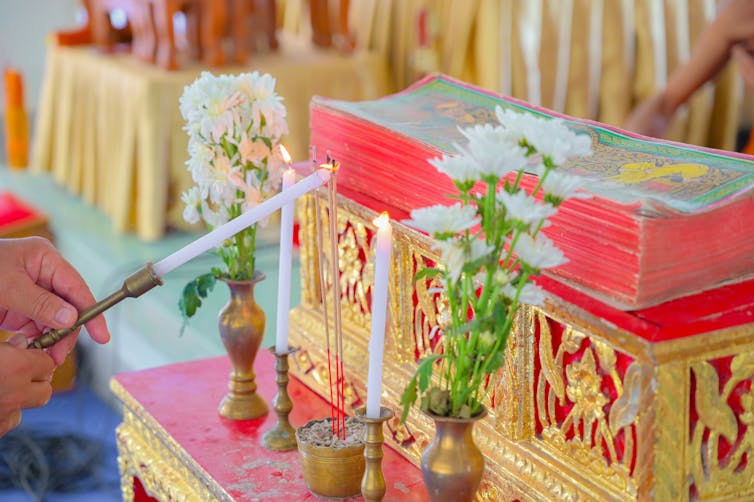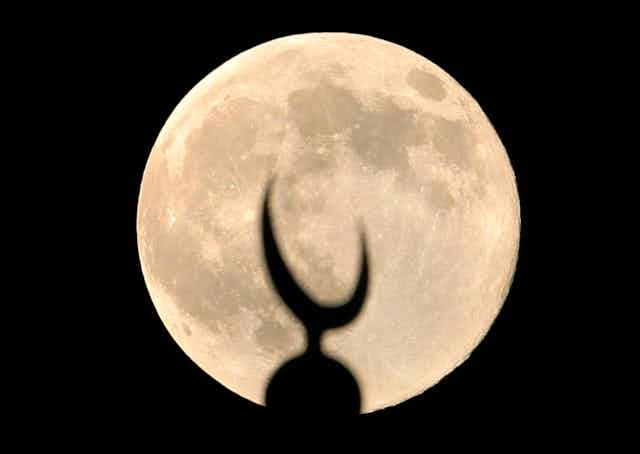Sending human remains to the Moon on the first commercial lunar lander, Peregrine 1, on Jan. 8, 2024, along with scientific instruments, caused a controversy.
Buu Nygren, president of the Navajo Nation, objected, saying that “the moon holds a sacred place” in Navajo and other tribal traditions and should not be defiled in this way. The inside of the lander was to be a kind of “space burial” for remains of some 70 people. Each of the families had paid over US$12,000 for a permanent memorial on the Moon.
As professors of religious studies who have taught courses on death rites, we know that death rituals in the world’s religions have been shaped by millennia of tradition and practice. While these ashes didn’t make it to the Moon because of a propellant leak, their presence on the lander raised some important religious issues: Beliefs about the polluting nature of the corpse, the acceptability of cremation and the sacredness of the Moon vary across traditions.
Jewish death rituals and purification
In ancient Judaism, certain activities were believed to be polluting, rendering a person unfit to participate in prayers and animal sacrifices offered exclusively at the Temple in Jerusalem. There were many ways in which one could become ritually unclean, and each level of pollution was cleansed by an appropriate purification rite. Direct contact with a human corpse was believed to cause the most intense form of pollution; even touching a person or object that had been in contact with a corpse would cause a lesser level of defilement.
After the Romans destroyed the Temple in 70 C.E., Jewish religious practice changed dramatically, including rules about purification. These days, after a burial or visit to a cemetery, many Jewish people wash their hands to wash away negative spirits or energy.
In Judaism, the bodies of the dead are to be buried or entombed in the earth. Cremation of human bodies, rejected for centuries, has become more popular but still remains a controversial option due to the older tradition of respect for the body as a creation of God – to be buried intact and without mutilation.
Christian death rituals over the centuries
Before Christianity developed in the first century C.E., Roman civil religion stressed the need to separate the living from the dead. Corpses or cremated remains were interred in burial places outside cities and town – in the necropolis, literally a city of the dead. As in Judaism, any visitor needed purification afterward.
As monotheists, Christians rejected belief in the Greek and Roman gods and goddesses, including the Moon goddess called Selene or Luna. They also refused to participate in Roman state religious rituals or activities based on pagan polytheism. Decades later, after Christianity became the official imperial religion, Christians moved the remains of people they considered holy into towns and cities to be re-entombed for easier veneration inside churches.
During the medieval period, ordinary Christians desired to be buried close to these saints in anticipation of the resurrection of the body at the second coming of Christ. Graveyards around the church were consecrated as “holy ground.” In this way, Christians believed that the departed might continue to benefit from the holiness of the saints. Their bodies were considered sources of spiritual blessing rather than causes of spiritual pollution.

Increasingly today, cremation is considered acceptable, although the Catholic Church requires that cremated remains must not be scattered or partitioned but buried or placed elsewhere in cemeteries.
Unlike some other religions, neither Judaism nor Christianity considers the Moon divine or sacred. As part of God’s creation, it plays a role in setting the religious calendars. In both Jewish and Christian spiritual writing, the Moon is used as a spiritual analogy: in Judaism, of the majesty of God, and in Christianity, of Christ and the church.
Islamic beliefs on burial
Cremation is strictly prohibited in Islam. After death, the deceased is ritually washed, wrapped in shrouds and brought for burial in a cemetery as soon as possible.
After a funeral prayer, led by an imam or senior member of the community, the deceased is buried – usually without a coffin – with their head oriented toward the holy city of Mecca. The soul of the deceased is said to visit their loved ones on the seventh and 40th days after death.
The Quran warns against worshiping the Moon, as was done in pre-Islamic culture, because worship is due to God alone.
In September 2007, when the first Muslim astronaut from Malaysia got ready to go into space, the Malaysian National Space Agency published religious directives on burial rituals for Muslims in space. These directives said if bringing the body back wasn’t possible, then he would be “interred” in space after a brief ceremony. And if no water was available in space for the ceremonial rituals, then “holy dust” should be swept onto the face and hands “even if there is no dust” in the space station.
Hindu and Buddhist funerary practices
Hinduism is a diverse religion, and so funeral practices often vary according to culture and context. Most commonly, death and the period following a person’s death are associated with ritual pollution. Because of this, the deceased should be cremated within 24 hours after death.
The cremation of the corpse cuts the ties of the soul, or the atman, to the body, allowing it to move on to the next level of existence and eventually be reincarnated. The ashes are collected and placed into an urn on the third day after cremation and immersed in a body of water, ideally a sacred river such as the Ganges.
Within Hinduism, the Moon has played an important role in conceptualizing what happens to the dead. For example, the ancient Hindu texts describe the spirits of the virtuous dead as entering Chandraloka, or the realm of the Moon, where they experience happiness for a time before being reincarnated.
In the many forms of Buddhism, death provides an opportunity for mourners to reflect on the impermanence of all things. While in Tibetan Buddhism there is the tradition of “sky burial,” in which the deceased is dismembered and left to the elements, in most forms of Buddhism the dead are usually cremated and, as in Hinduism, the corpse is considered polluting beforehand.

In older forms of Buddhism in Nepal and Tibet, the Moon was understood to be identified with the god Chandra, who rides on a chariot. The Moon is also one of the nine astrological deities whose movement provides insight for reckoning individual and collective futures.
Difficult questions
In response to the Navajo objection that landing ashes on the Moon was a defilement, the CEO of Celestis, the company that paid for capsules containing the ashes, issued a statement stressing that launching containers of human ashes to the Moon is “the antithesis of desecration … it’s celebration.”
In the end, the question was moot. Peregrine 1 never made its soft landing on the Moon because of an engine malfunction, and its payload was destroyed after entering the atmosphere.
As more people decide to send their ashes into space, however, religious conflicts are bound to arise. The key concern, and not just for the Navajo Nation, will be how to respect all religious traditions as humans explore and commercialize the Moon. It still remains a problem today here on Earth.

